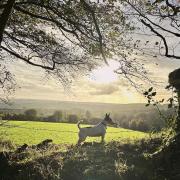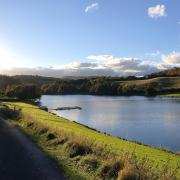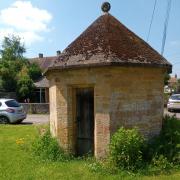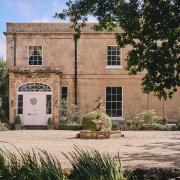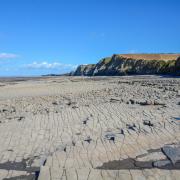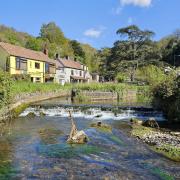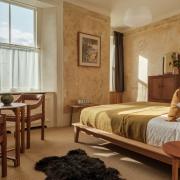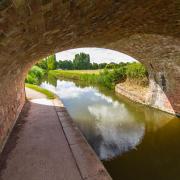It’s been more than a century since the coal pits in Timsbury closed but you don’t have to dig deep to find a rich vein of mining heritage in the culture of the village. Even on the surface there is the miner’s silhouette on a northern corner, there’s the miner’s memorial garden in the centre, the Upper Conygre batch (slag heap) shadowing the village hall and the recreation ground itself is still technically owned by the Somerset Miners Welfare Trust.
What makes Timsbury different from other North Somerset Coalfield villages is that alongside all the miners’ cottages there are several late Georgian, now listed, mansions – as this was where the mining entrepreneurs came to live cheek by jowl with the workers. The architectural centrepiece, literally, would have been Timsbury House, built in Tudor times it was the home of the wealthy Sambornes for centuries. The family moved out in 1938, it was used by the army during the war, then briefly as a finishing school for young ladies before, sadly, being demolished in 1961. So central was the building that the Sambornes built a ha-ha and even diverted a road to keep the colliers and their families out of sight.

A consequence of the coal tradition, which goes back to the 16th century, is that there is a multitudinous network of footpaths in the area that the miners would use to travel to other pits. So much so that a group of walker/writers have in recent years produced several books on nearby circular walks. The 100th walk was celebrated with a visit from Clare Balding on one of her Rambles for Radio Four. I met up with Larry Cunningham, one of the co-authors, at The Conygre Hall – so we went for a walk. Past the site of the Timsbury Horse Show, a major equestrian event for almost 50 years entertaining the likes of Harvey Smith, the Edgars, even Princess Anne and Captain Mark Phillips before their engagement and on to the Square. The centre of the village has been the location for 97 recorded shops, in the past, plus the old post office and the old police house but still hosts essentials like a chemist, two supermarkets, two hairdressers and a café called The Square. The graveyard of St Mary’s Church has the stones for miners alongside the grander tombs for the mine-owners. An oddity is that one Mary Newth who died on 2nd January 1855 aged 99, has two gravestones.
A short wander and you get the panoramic view of open countryside at the top of Prior’s Hill. Larry said: ‘How to capture Timsbury, from my point of view, is not so much the village, the buildings, important as they are, it’s the fact that you walk a few hundred yards and you get these views. It’s the same when you go up on the Sleight, except north, you can see all the way to Bristol see the Clifton Suspension Bridge and the bridges across the Severn. All on the doorstep of Timsbury, it’s a little enclave here.’

The view south may be rural now but two hundred years ago it would have been an industrial landscape, complete with tramways taking the coal down to the Somerset Coal Canal. The SSC Society is now trying to restore the canal and get it back through to the Kennet and Avon where it concluded when it closed in 1898. Across the valley you can see Rugbourne Farm, the home of William Smith, the man considered to be the Father of British Geology who produced the first geological map of a country and was also associated with the Somerset Coal Canal.
Continuing along the southerly side you get a rear view of one of those Georgian homes, Parish’s House, where Bernard Cayzer used to live. Bernard was a great benefactor to the village during the second half of the last century, paying for half of the village hall as well as heading up various sporting organisations including the horse show. The house was originally built for a Captain Parish who married into the mining community and reputedly got his money from pirate’s bounty.
Famous recent residents: Fred Wedlock (Comedian/singer). Susan Chilcott (Soprano). Anthony Head (Actor).
Vines not Mines
Alongside Lower Conygre batch on the limestone south easterly slopes of Timsbury, at an eight acre plot, a former medical oncologist is nurturing 8,000 vines. Professor Christopher Poole is seeking to turn his scientific brain to the art of viticulture and fulfill a lifelong dream of making wine.
Vines need to be four years old before you can go into proper production, his are just three, so this autumn he will be taking off his shoes and socks and doing a bit of grape stomping in a spirit of experimentation – next year will be the real test.
On the top fields he has Chardonnay, Bacchus (popular grape in England because of the climate), Pinot Noir and various mutants of the latter such as Pinot Precose. Lower down there are an assortment of red grapes which are disease-resistant Swiss hybrids. Ultimately the grapes will go off to a professional winery, ‘I don’t have time to learn from my mistakes’, but he will insist on ‘Lower Conygre Vineyard’ and ‘Timsbury’ on the label. Particular wines may be called ‘bacchus batch’ or ‘pithead pinot’.
INFO
Population: 2,624 (2011 census)
STAY
There are four cottages to rent at Withy Mills working farm at Timsbury Bottom. Sympathetically restored from stone barns with whirlpool bath and underfloor heating. Peppered with five-star reviews. withymillsfarm@gmail.com




